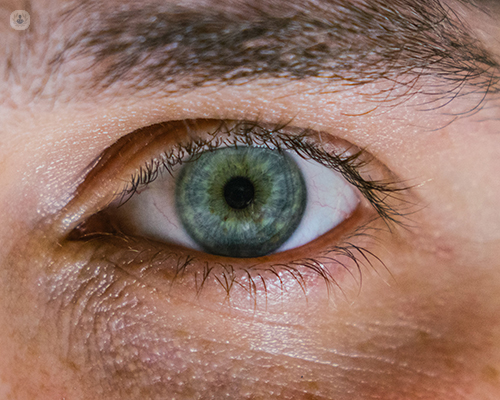Retinal tear
Mr Jonathan Dowler - Ophthalmology
Created on: 04-24-2020
Updated on: 03-29-2023
Edited by: Jay Staniland
What is a retinal tear?
A retinal tear is when the thin layer at the back of your eye (retina) is torn. This creates a risk of retinal detachment and severe loss of vision.
Prognosis of a retinal tear
If a retinal tear is detected early, before it progresses to retinal detachment, the prognosis is very good. If retinal tears are left untreated, then there is a very high risk of the patient developing retinal detachment which ultimately means loss of eyesight.

Symptoms of a retinal tear
- An onset of black spots or “floaters”
- Flashes of light (photopsia)
If there is associated vitreous haemorrhage (bleeding in the clear cavity of the eye) or retinal detachment, additional symptoms can include shadows and blurred vision as though they’re closing in from the peripheral (side) vision. However, a retinal tear may not manifest any noticeable symptoms.
How can a retinal tear be detected?
A timely and thorough examination should be carried out by an ophthalmologist using scleral depression (applying slight pressure to the eye) and/ or 3-mirror lens is the most important step in order to be able to diagnose a retinal tear.
What are the causes of retinal tear?
As you age, the gel-like material that fills the inside of your eye, known as the vitreous, may change in consistency and shrink or become more liquid. The vitreous separates from the surface of the retina, usually without any complications. However, in people who have a more “sticky” vitreous, as the vitreous separates from the retina, it pulls abnormally and causes the retina to tear.
Can a retinal tear be prevented?
Although retinal tears may also occur as a result of eye trauma, most retinal tears occur spontaneously. Of course, eye trauma should be avoided, however, there are no guidelines to prevent a tear developing in the retina. If you do notice any symptoms, getting these checked and, if necessary, treated quickly can reduce the risk of developing a retinal detachment.
It’s also important to get comprehensive dilated eye exams regularly. A dilated eye exam can help your eye doctor find small retinal tears or signs of retinal detachment early, before it starts to affect your vision. Early treatment can help prevent permanent vision loss.
How should a retinal tear be treated?
Not all retinal tears require treatment. Sometimes, when low-risk tears are identified in patients who have no symptoms, these tears may not require treatment. Some tears heal themselves by developing adhesion around the tear without treatment.
The severity of the tear will influence the decision on what treatment option is used. Your eye surgeon will suggest various methods of repair and will suggest the best treatment based on the severity of the tear or retinal detachment. These are some of the options available:
- Laser photocoagulation is helpful in repairing small retinal tears. The laser burns tiny areas around the edges of the tear, which produces scars. Once these areas heal, the scars seal the borders of the tear and thus prevent fluids from leaking toward the retina. This helps to avoid detachment. Laser treatment requires no surgical incision and causes less damage to surrounding tissue.
- Cryopexy uses extreme cold to cause scars and helps seal the edges of a retinal tear. It requires local anaesthesia to numb the eye.
- Liquid silicone is also an option, it may be injected to replace the vitreous fluid to maintain the normal shape of the eye and hold the eye wall in alignment as well as the retina.
Which type of specialist treats retinal tears?
An ophthalmologist would treat a retinal tear. It’s a good idea to have regular routine eye exams to monitor the health of your eyes and to ensure no symptoms of retinal tears or retinal detachment are present.
Click here to find the retinal tear specialist for you.





